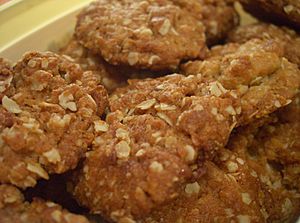Anzac biscuit facts for kids
 |
|
| Alternative names | ANZAC biscuit |
|---|---|
| Type | Biscuit |
| Associated national cuisine | Australia, New Zealand |
| Main ingredients | Rolled oats, flour, desiccated coconut, sugar, butter, golden syrup |
The Anzac biscuit is a sweet and crunchy biscuit (like a cookie) that is very popular in Australia and New Zealand. It's made with ingredients like rolled oats, flour, sugar, butter, and golden syrup. Sometimes, it also has dried coconut.
These biscuits have a special connection to the Australian and New Zealand Army Corps (ANZAC). This group of soldiers was formed during World War I.
There are different stories about why Anzac biscuits became famous. One story says that wives and women's groups sent these biscuits to soldiers fighting far away. This was because the biscuits don't spoil easily and stayed fresh during long trips by ship.
However, another story says that Anzac biscuits were mostly eaten by people at home in Australia and New Zealand. They would sell these biscuits to raise money to help with the war effort. It's not completely clear which story is true. But there is proof that soldiers did receive homemade biscuits during World War I. So, it's possible they received Anzac biscuits too!
It's important not to mix up Anzac biscuits with "ANZAC wafers." These wafers were a type of hard biscuit (called hardtack) that soldiers ate. They were very different from the sweet Anzac biscuits we know today.
How Anzac Biscuits Started
The first known recipe using the words 'Anzac' and 'biscuit' was for "ANZAC GINGER BISCUITS." It appeared in a newspaper in Perth, Australia, in 1916. But this recipe didn't have oats, which are a key ingredient in today's Anzac biscuits.
The first recipe actually called "Anzac Biscuits" was in an Australian cookbook from 1917. However, this recipe was also for a different kind of biscuit. The same cookbook did have recipes for biscuits that looked like modern Anzac biscuits, but they were called "Rolled Oats Biscuits" or just "Biscuits."
The first time the name 'Anzac biscuit' was used for the recipe we know today was around 1919 or 1920 in Adelaide, Australia. Another early recipe appeared in an Australian newspaper in 1921. These early recipes didn't include dried coconut. The first recipe for an Anzac biscuit with dried coconut was found in Adelaide in 1924.
In New Zealand, a recipe called "Anzac Crispies" from 1919 had ingredients very similar to modern Anzac biscuits.
Anzac Biscuits Today
Today, you can buy Anzac biscuits in stores everywhere. They are still very popular. Because of their link to the ANZAC soldiers and ANZAC Day, these biscuits are often sold to raise money. The money goes to groups like the Royal New Zealand Returned Services' Association (RSA) and the Returned and Services League of Australia (RSL). These groups help soldiers and their families.
Around Anzac Day, you might even find special collector tins of these biscuits. These tins often have old military artwork on them. The official RSL biscuit is made by a company called Unibic.
You can also find a British version of the Anzac biscuit in some supermarkets in the UK. These biscuits support the Royal British Legion, another group that helps military families.
Rules for the Name "Anzac"
The word "Anzac" is very special in Australia. It is protected by Australian law. This means you can't use the term "Anzac" without getting permission from the government, especially for selling things. If you use it wrongly, there can be legal problems. New Zealand also has similar rules.
However, there's a special rule for Anzac biscuits. You can use the name "Anzac biscuit" as long as the biscuits are made mostly like the original recipe. Also, they must always be called "Anzac biscuits" and never "cookies".
This rule caused a problem for the Subway restaurant chain in 2008. They used to sell Anzac biscuits. But the Australian government told them they had to bake the biscuits using the original recipe. Subway found it was too expensive for their supplier to make them that way, so they stopped selling them.
See also
 In Spanish: Anzac biscuit para niños
In Spanish: Anzac biscuit para niños

